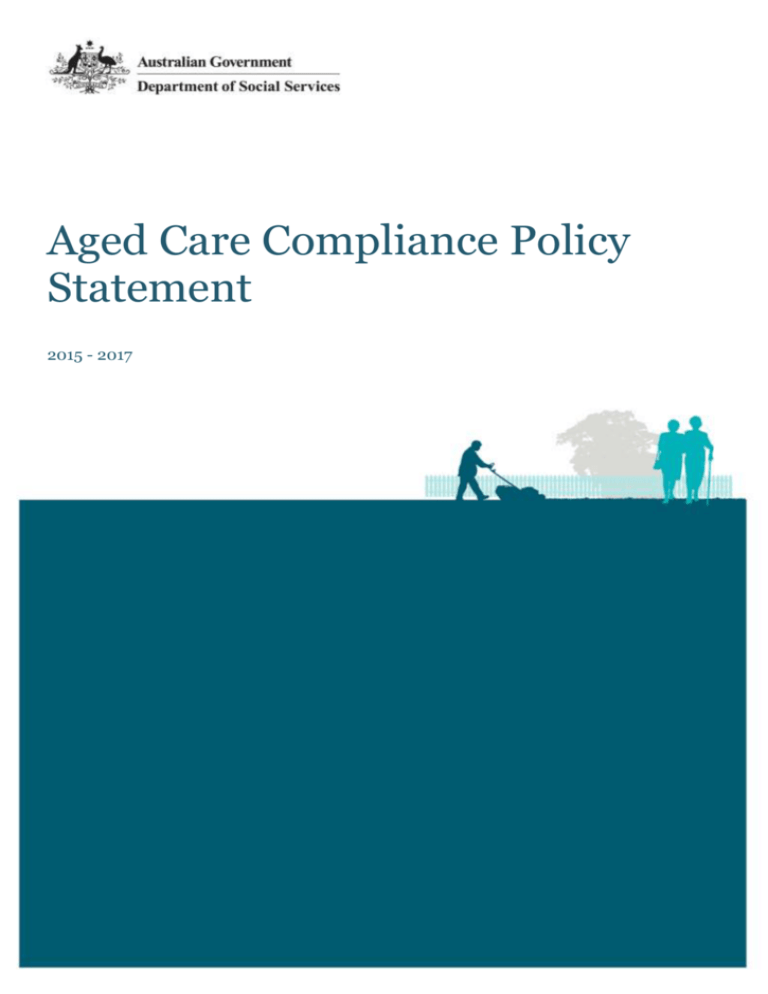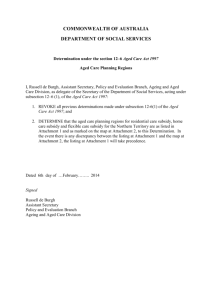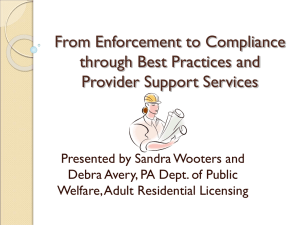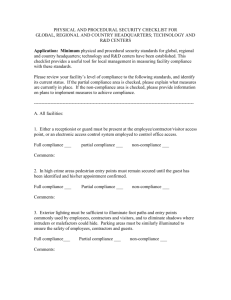Aged Care Compliance Policy Statement
advertisement

Aged Care Compliance Policy Statement 2015 - 2017 Aged Care Compliance Policy Statement Table of Contents Glossary and Acronyms .......................................................................................................................... 3 Part 1: Context and purpose of this policy .......................................................................................... 4 Part 2: Our compliance objectives, approach and principles ............................................................. 5 Part 3: Our compliance strategies ...................................................................................................... 6 Encouraging and promoting compliance by educating and informing ................................................ 7 Monitoring compliance......................................................................................................................... 7 Engaging with the provider .................................................................................................................. 8 Assessing risk ...................................................................................................................................... 9 Selecting a response ........................................................................................................................... 9 Administrative resolution of identified non-compliance ..................................................................... 10 Monitoring the provider’s return to compliance ................................................................................. 11 Part 4: Reconsideration, review and reporting ................................................................................. 11 Reconsideration ................................................................................................................................. 11 Review by the Administrative Appeals Tribunal ................................................................................ 12 Commonwealth Ombudsman ............................................................................................................ 12 Reporting non-compliance................................................................................................................. 12 Report on the Operation of the Act .................................................................................................... 12 Part 5: Feedback and continuous improvement ............................................................................... 13 Attachment A ..................................................................................................................................... 14 Further information about some of the Department’s options for managing non-compliance .............. 14 A. Regulatory options under the Act .................................................................................................. 14 Regulatory notices ............................................................................................................................. 14 Sanctions action ................................................................................................................................ 14 B. Other regulatory options ................................................................................................................ 16 ACFI non-compliance ........................................................................................................................ 16 Directions by the Aged Care Complaints Scheme ............................................................................ 17 Revocation of approved provider status ............................................................................................ 17 C. Contractual actions ....................................................................................................................... 18 2 Aged Care Compliance Policy Statement Glossary and Acronyms AAT Administrative Appeals Tribunal ACFI Aged Care Funding Instrument Act the Aged Care Act 1997 Quality Agency the Australian Aged Care Quality Agency Department the Australian Department of Social Services FOI Freedom of Information HACC Home and Community Care NNC Notice of non-compliance NTR Notice to remedy RAD Refundable Accommodation Deposit DAP Daily Accommodation Payment key personnel as defined in section 8-3A of the Act provider an approved provider of aged care under the Act or a service provider funded under a contract or agreement with the Australian Government NATSIFACP National Aboriginal and Torres Strait Islander Flexible Aged Care Program 3 Aged Care Compliance Policy Statement Part 1: Context and purpose of this policy The Department of Social Services (the Department) aims to improve the lifetime wellbeing of people and families in Australia. In pursuit of this objective, the Australian Government subsidises the provision of aged care services to over one million older people each year. Aged care services funded by the Australian Government include: • • services funded under a contract or agreement between the Australian Government and the provider such as: – low intensity support through the Commonwealth Home and Community Care (HACC) program; – support to Aboriginal and Torres Strait Islander clients through the National Aboriginal and Torres Strait Islander Flexible Aged Care Program; and – respite support through the National Respite for Carers program (NRCP). services operated by providers that are approved under the Aged Care Act 1997 (the Act). There are currently three types of care under the Act: home care; flexible care; and residential care. In return for Government subsidy and payments and care recipient fees and payments, providers of aged care are expected to meet certain requirements relating to the provision of care and services. These requirements relate to, for example, the types of services that must be provided to care recipients, the quality of care to be provided and the fees that may be charged by providers. Depending on the nature of care provided, the Government’s requirements are set out in: • the Aged Care Act 1997 for providers of home care, flexible care and residential care; and/or • a contract or agreement with the provider. As a regulator, the Department has a responsibility to provide assurance to the Australian community that those providing care and services are suitable to do so and are meeting mandated requirements. The Department considers these matters: • prior to the provider commencing delivery of services. For example, the Department tests the suitability of a provider before approving them to provide aged care; • in the case of contracted service providers, the Department requires that certain terms and conditions are met prior to the commencement of the delivery of services; and • on an ongoing basis through the Department’s monitoring program. Once providers are approved or contracted to deliver aged care services, the Department adopts a systematic, risk-based program of compliance monitoring, assessment and action. This ensures that the Department targets its available resources at the highest risks, and proactively responds to changing and emerging risks. The purpose of this policy is to describe the Department’s approach to aged care compliance, once a provider has been approved or contracted to deliver aged care services. 4 Aged Care Compliance Policy Statement Part 2: Our compliance objectives, approach and principles Two objectives guide the aged care compliance strategy. The first of these is: to return the provider as quickly as possible to compliance with its responsibilities (under the Act or a contract) and deter future non-compliance, in order to protect the health, welfare or interests of care recipients of aged care services. The second compliance objective is: to ensure confidence in the national aged care compliance programme through timely, proportional, reliable, clearly articulated and well documented decisions. The paramount consideration throughout the aged care compliance process is the health, welfare or interests of current and future aged care recipients. To maximise efficient use of resources and minimise unnecessary burden on the sector, the Department adopts an approach that is both risk-based and utilises the conventional ‘regulatory pyramid’ model as follows: Enforcement Court Action Regulatory or Contractual Actions In the event of unresolved non-compliance action will be taken and may include sanctions, revocation of approved provider status or termination of contract or Agreement Regulatory or Contractual Actions Notices of Non- Compliance and an Undertaking to Remedy by the approved provider Deterrence Voluntary Compliance Education and Support Administrative Actions Requests for Information Monitoring Engagement Encourage and support compliance Compliance will be returned through education and support 5 Aged Care Compliance Policy Statement In dealing with providers, care recipients and other parties the Department acts in a manner that is consistent with good regulator practice (Productivity Commission’s Regulator Audit Framework, 2014). The Department: • applies a risk-based framework to decision making. This means that we: identify, evaluate and monitor risk; prioritise risk, based on assessments of likelihood and consequences; and plan and conduct activities to mitigate risk; • adopts a proportionate approach to non-compliance. We assess all of the information available and respond in a way that is reasonable and appropriate to the case at hand; • is fair. We act impartially and objectively. This means that we do not bring bias to our decisionmaking processes and we give all parties the opportunity to be heard. For example, if we identify alleged non-compliance, the provider has the opportunity to respond and to put their case to us, however we will take immediate action if care recipients face immediate and severe risk; • ensures that our decision-making processes are transparent. We do this by ensuring that information about our policies and decision making frameworks are publicly available and by ensuring that, in our dealings with individual providers, our decisions are accountable and transparent; • acts consistently. In order for stakeholders to have confidence in our decision making, we must be consistent in our approach. This does not mean that we will decide all cases in the same way (recognising that no two cases are the same) but it does mean that we apply consistent assessment procedures; review decisions before finalising them; and review cases to confirm that appropriate processes have been applied; • responds in a timely manner. We aim to undertake our compliance assessment and action in a timely way. By applying a risk-based approach to decision making, we can identify cases that are more serious (and require a more rapid response) and cases which are complex and may take longer to resolve. This means that the time taken varies from case to case. The Department is committed to ensuring that throughout the compliance process all parties are kept informed; and • is accountable. We act consistently with the legislation, contract/agreement, guidelines, policies and procedures and ensure that our decisions are appropriately and accurately communicated and documented. Part 3: Our compliance strategies We achieve our compliance objectives by employing a number of integrated strategies: • encouraging and promoting compliance by educating and informing; • monitoring compliance; • engaging with the provider to explore any concerns or queries the Department may have regarding compliance; and • responding to identified non-compliance through administrative resolution or enforcing the law or contractual obligations where necessary. Each of these strategies is discussed in more detail below. 6 Aged Care Compliance Policy Statement Encouraging and promoting compliance by educating and informing Providers will have sufficient information to enable them to comply The Department seeks to ensure that, once approved or contracted to provide Australian Government subsidised aged care, providers and their key personnel have sufficient information available to them to comply with their responsibilities. Information resources available to providers include: • the legislation (the Aged Care Act 1997, Aged Care (Transitional Provisions) Act 1997, the Aged Care Principles and the Aged Care (Transitional Provisions) Principles 2014; • My Aged Care phone line (1800 200 422) and website (myagedcare.gov.au); • information sheets on various matters including the prudential arrangements for accommodation bonds and payments, refundable accommodation deposits (RADs) and daily accommodation payments (DAPs) and the rules relating to fees and charges; • the Aged Care Funding Instrument (ACFI) User Guide; • Home Care Packages Programme Guidelines; • The Guide to Aged Care Law; • Commonwealth HACC Program Manual; and • The Terms and Conditions for Aged Care Funding booklet. In some cases, non-compliance results from providers being unaware of a particular requirement, or being uncertain as to how to meet a requirement. This can give rise to unintended non-compliance with the legislation or with the terms of a contract or agreement. The approach to compliance therefore includes: • identifying trends or common areas of challenge for providers and providing information on communicating these topics through various channels, including presentations to provider groups, the Department’s website, and newsletter bulletins; and • provision of education and advice to individual providers. For example, if a complaint is made through the Aged Care Complaints Scheme, Scheme officers work with the complainant and the provider to try to address the issue. This provides an opportunity for Scheme officers to speak with providers to ensure that they have an understanding of the Government’s requirements. Monitoring compliance An essential element of the Department’s compliance strategy is monitoring compliance and assessing risk. The Department monitors compliance through a range of mechanisms. For example: • The Quality Agency assesses and monitors: – Accredited residential aged care services against the Accreditation Standards (including accreditation); – Home care, flexicare, HACC/NRCP services against the Home Care Standards; and 7 Aged Care Compliance Policy Statement – National Aboriginal and Torres Strait Islander Flexible Aged Care Program (NATSIFACP) services against the NATSIFACP quality framework. • If non-compliance is identified with the relevant standards or framework, the Quality Agency will require the provider to address the non-compliance and will inform the Department of the noncompliance. The Department will assess the risk and decide if it will take any action in relation to the non-compliance; • the Aged Care Funding Instrument (ACFI) Review Programme involves Departmental officers auditing providers’ compliance with the ACFI; • the Department receives and reviews information (such as Annual Prudential Compliance Statements) about the prudential performance of providers; and • the Aged Care Complaints Scheme receives complaints from care recipients, their carers and other members of the public about aged care services. These complaints are examined, and where necessary, investigated by the Department. Information obtained through the complaints scheme can lead to further detailed investigations of the provider’s non-compliance with legislated or contractual responsibilities. The Department also receives information about potential non-compliance through: • observations and reports from other agencies or regulatory authorities such as hospitals, paramedics and health complaints bodies; • contractual management and engagement with providers of HACC and respite care programs; • analysis of intelligence including information, data, financial records and reports; • public information such as media reports and letters to Members of Parliament and to the Department; and • self-reporting by aged care providers. Engaging with the provider When non-compliance (or potential non-compliance) is identified, the Department’s first objective is to build a clear picture of the problem to inform decision-making. The Department gathers relevant information and considers the reliability of the information. The Department will only use information that is objective (a fact, not an opinion), relevant and defensible (able to stand up to scrutiny and questioning). If the Department has concerns that a provider may not be complying, or may become unable to comply, the focus of the Department’s approach is to engage with the provider. This gives the provider the opportunity to explain the situation and, where possible, address the Department’s concerns without the need for the Department to take further action. To better understand the nature of the potential or identified non-compliance, the Department may also seek information from the Quality Agency, from within the Department (including information held on databases such as information about the care recipients at the service, their care needs and funding) or from other agencies. 8 Aged Care Compliance Policy Statement Assessing risk The Department also gathers information about the context in which the non-compliance is occurring to inform the assessment of potential risk. This can be influenced by a wide range of factors including the number of care recipients potentially affected, the health status of those care recipients and the capacity of the provider to address the problem. To understand the risks, the Department considers the following contextual information: • structural or inherent risks. These are risks which relate to the fundamental nature of the service. For example, buildings which were constructed for purposes other than aged care may present a structural risk in aged care service delivery; • situational or short-term risk. This refers to risks associated with a situation that has arisen, but is not a permanent feature of the service. For example, if there has been a recent change in ownership of a service or a temporary staff shortage this may impact, in the short term, on the capacity of the provider to address the non-compliance and the risk posed to the care recipients; • governance risk. Governance risks are risks that arise from the direction and control of the service including financial risks. For example, the history of non-compliance and the relationship between the service and its governing body. Considering the compliance history of a provider does not influence the Department’s decision as to whether there is non-compliance in the particular case, but instead influences decision making around overall risk and how to respond to the potential non-compliance; and • exceptional risk. This refers to those risks that are extraordinary and cannot reasonably be prevented by the provider, such as natural disasters. In such circumstances there may be noncompliance that does not warrant the Department’s attention in the short term, while more significant risks to care recipients are being attended to. Selecting a response The response adopted by the Department depends on the risks posed by the non-compliance and the providers response to the Department’s concerns. The central and first concern of the Department is risks to the health, welfare or interests of current and or future care recipients of aged care services. In determining appropriate responses to non-compliance the Department may also consider such factors as: • the objectives of the legislation, contract or agreement; • the seriousness of the harm caused by the non-compliance; • the level of malice or culpability – was the contravention intentional, reckless, negligent, or a mistake?; • whether there is a history of prior non-compliance; • the cost to the Australian Government or general community of the non-compliance; • the likelihood of the response being effective in returning the provider to compliance as quickly as possible; • the prevalence of the type of non-compliance; 9 Aged Care Compliance Policy Statement • the impact of the non-compliance on community confidence and the manner in which it is dealt; and • the most appropriate response to ensure an effective deterrent against continuing contravention or contravention by others. The focus of the Department’s efforts in managing non-compliance is to return the provider to compliance as quickly and efficiently as possible. Flexibility in responding to non-compliance enables the Department to: • implement a response that is targeted at the highest priority risks posed by the non‐compliance; • be proportionate to the risks posed by the non‐compliance; • recognise the capacity and motivation of the provider to return to compliance; and • signal the seriousness with which the Department views the non‐compliance. Administrative resolution of identified non-compliance Where non-compliance is identified, the Department will often seek to address the non-compliance through administrative resolution in the first instance (depending on the risk posed by the noncompliance). After raising the Department’s concerns with the provider, the Department may ask the provider to take responsibility for looking into the non-compliance and proposing a solution. During this period the Department continues to engage with the provider and may require additional reporting to enable the Department to monitor progress towards rectifying the non-compliance. Where the provider demonstrates a willingness to act, and an understanding of the problem, this approach can deliver positive results which avoid the need for the Department to take legal action under the Act or contract/agreement. The Department is, however, unlikely to adopt this approach for conduct that recurs after having been subject to a previous administrative resolution. This option may also be inappropriate based on the level of risk. Enforcing the law or contractual obligations where necessary. In some circumstances, the Department’s compliance objectives cannot be met through education/support or it is not appropriate to seek compliance through these means. For example, there may be circumstances where: • the non-compliance significantly affects or threatens to affect the health, welfare or interests of current and or future care recipients; • a provider has a long history of non-compliance and failed to improve practices despite education and support; • care recipients are at immediate and severe risk; • a provider is acting in an allegedly fraudulent way; • a provider has failed to address non-compliance through an administrative resolution process; or 10 Aged Care Compliance Policy Statement • the provider is unable to address the non-compliance and may no longer be suitable to provide aged care. In these and other circumstances the Department draws on its rights under contract and its powers under legislation to take action. For example, the Department may commence sanctions action or may take legal action under a contract. Regulatory and contractual options are discussed in more detail in Attachment A. Monitoring the provider’s return to compliance As part of its response to non-compliance, the Department also implements a monitoring strategy to ensure that the provider returns to compliance. The monitoring strategy will depend on the circumstances of the case but may include: • meetings with the provider for a period of time; • reporting by the provider for a period of time; and/or • monitoring visits by the Department or the Agency for a period of time. If the provider is not making timely progress to rectify the non-compliance the Department will consider what additional action may be required to ensure the provider meets its responsibilities. Part 4: Reconsideration, review and reporting Reconsideration Where the Department takes certain action against a provider for non-compliance, the provider may seek reconsideration of the decision. The right to seek reconsideration of certain decisions is expressly described in the Act (for certain decisions such as a decision to impose a sanction) or for decisions made under contract or agreement, the Department may undertake a common law reconsideration. The reconsideration process commences with the provider making a written application for reconsideration within 28 days of receiving the original decision. A different decision maker within the Department then reconsiders the original decision (within 90 days) and decides whether to: confirm the decision; vary the decision; or set the decision aside and substitute a new decision. The decision maker on reconsideration will: • review the available evidence and material, including the applicant’s application for reconsideration and any additional evidence made available since the time of the original decision; • consider the strength of the evidence and the potential arguments to vary, set aside or confirm the original decision; and • seek any additional information. 11 Aged Care Compliance Policy Statement The decision will be clearly communicated to the applicant for reconsideration including all reasons for the reconsideration decision. Review by the Administrative Appeals Tribunal The approved provider may apply for review by the Administrative Appeals Tribunal (AAT) if the provider has first sought a reconsideration of a “reviewable decision” under the Act, and the Department has determined that the original decision should stand. The AAT undertakes merits review of administrative decisions. The purpose of merits review is to review a decision in order to decide whether that decision is the ‘correct or preferable’ decision. The facts, law and policy aspects of the original decision are all considered afresh by the AAT and a new decision, confirming, varying or setting aside the original decision is made. Decisions are usually given within two months of the AAT hearing. AAT decisions and reasons given in writing are usually made publicly available, including on the internet. Commonwealth Ombudsman The Commonwealth Ombudsman can investigate the administrative actions of Commonwealth Government officials or agencies. If the Ombudsman finds that a complaint is justified, conclusions and recommendations will be reported to the Department and the complainant. If adequate and appropriate action is not taken within a reasonable time in response to a recommendation, the Ombudsman may make a formal report to the relevant minister, the Prime Minister or a special report to Parliament. Reporting non-compliance In the interests of enabling consumers to make informed choices about aged care services, the Department publishes information about certain compliance action that has been taken under the Act, specifically the issue of Notices of Non-Compliance (NNCs) and Sanctions (discussed in more detail in Attachment A). The Department publishes on the My Aged Care website: • the names and addresses of aged care services where a NNC has been issued or sanctions are in place; • the names of the providers of the services; • the action taken under the Act and the reasons for the action; and • the status of the action. Information published about NNCs remain on the website for a period of two years from the date of issue. Information on sanctions which have expired or have been lifted is archived on the Department’s website. Report on the Operation of the Act The Report on the Operation of the Aged Care Act 1997 (ROACA) provides an in-depth look at the operation of the Act for each financial year. ROACA includes information about compliance activity, sanctions and the Agency. ROACA can be found on the Department’s website. 12 Aged Care Compliance Policy Statement Part 5: Feedback and continuous improvement Feedback is important to the Department. It helps us to: • build a picture of aged care services which enables us to better undertake risk assessment; • adjust standards or requirements, where there is room for improvement; and • honestly appraise our own performance and to make changes to policies and procedures to ensure there is continuous improvement. The Department receives feedback in a number of different ways: • from providers; • from the Quality Agency; • various committees provide advice directly to the Minister or the Department; • each time a provider or a complainant has contact with the Aged Care Complaints Scheme they are invited to provide feedback (through completion of a feedback form) to the Department; • from the AAT. The Department regularly reviews the outcomes of AAT decisions and uses this information to make changes to policies, procedures and, if necessary, legislation; and • from the Commonwealth Ombudsman. The Ombudsman considers and investigates complaints regarding the Department’s interaction with providers of aged care, care recipients or other parties. As part of the continuous improvement process, the findings of the Ombudsman are considered by the Department and acted upon. If you wish to provide feedback to the Department about this policy or any other aspect of the Department’s compliance program, please contact: Aged Care Compliance C/- Standards, Indicators and Compliance Branch Department of Social Services GPO Box 7575 Canberra Mail Centre, ACT, 2601 Email: aged.care.compliance@dss.gov.au Phone: 1800 200 422 13 Aged Care Compliance Policy Statement Attachment A Further information about some of the Department’s options for managing non-compliance A. Regulatory options under the Act Regulatory notices In many cases, a regulatory notice is used to gather information from the provider that may be relevant to informing how the Department proceeds, where non-compliance (or apparent noncompliance) has been identified. The Act describes four different types of regulatory notices: • Section 9-2 notice - This notice creates an obligation on the provider to give information relevant to the provider’s suitability to be a provider of aged care when requested, and within the legislated timeframe as specified in the written notice. • Section 9-3A notice - This notice creates an obligation to give information relating to the monies (accommodation bonds and/or entry contributions) currently or previously held by the provider. • Section 9-3B notice - This notice creates an obligation to give information relevant to the provider’s financial affairs, (directly related to their ability to repay bonds as and when they fall due, financial difficulty and/or bond use) to be provided periodically. • Section 93-1 notice - This notice is the strongest information gathering power available under the Act. The Department may issue a notice requiring any person whom it is believed on reasonable grounds, is capable of giving information relevant to a provider’s suitability, affairs, situation etc to attend before an authorised officer, at a particular time and place specified in the notice to answer any questions and provide documents as referred to in the notice. Sanctions action The Act provides for two pathways (commonly referred to as the long pathway and the short pathway) by which sanctions can be imposed, depending on the nature of the non-compliance: • the long pathway commences with the issue of a NNC and ends in the issuing of a Sanction Notice; and • the short pathway is the immediate imposition of sanctions due to an immediate and severe risk to the health, safety or well-being of current and or future care recipients. The short pathway or ‘straight to sanctions’ process omits the issue of a NNC (and related actions) applicable to the long pathway. A Sanction Notice is issued at the outset. In either case the Department can impose sanctions such as: • revoking or suspending approval as a provider of aged care services. This is a common sanction that is imposed unless the provider appoints an administrator or a clinical adviser, or implements training for staff; 14 Aged Care Compliance Policy Statement • restricting approval to existing services or places; • restricting funding to existing care recipients; or • prohibiting the charging of accommodation charges, accommodation bonds or accommodation payments, including RADs and DAPs. In deciding whether or not to impose sanctions, the Department will consider: • whether the non-compliance is minor or serious; has occurred before, and if so, how often; or threatens the health, welfare or interests of the residents or future residents; • whether the provider has failed to comply with any undertaking to remedy the non-compliance; and • the desirability of deterring any future non-compliance. Notice of non-compliance (NNC) and Notice to Remedy (NTR) If the Department considers that the provider is non-compliant with its responsibilities, the Department may issue a NNC, detailing the Department’s concerns and requesting a response from the provider. If the provider’s submission in response to a NNC proposes appropriate action to remedy the noncompliance, (or provides sufficient reason for the non-compliance or is otherwise satisfactory) the Department can give the provider a notice to remedy (NTR) requiring the provider to give a written undertaking to remedy the non-compliance. The undertaking that the provider must sign sets out: • a description and acknowledgement of the provider’s non-compliance with its responsibilities; • the action which the provider proposes to take to remedy the non-compliance; • the timetable for carrying out the action; and • an acknowledgment that failure to fulfil the undertaking may lead to sanctions being imposed. Notice of intention to impose sanctions If the provider does not make a submission in response to a NNC or if the Department considers that the submission: • does not propose appropriate action to remedy the non-compliance; • fails to establish that the non-compliance did not occur or is not occurring (i.e. does not challenge the charge of non-compliance); • fails to provide a sufficient reason for the non-compliance; or • is otherwise unsatisfactory; the Department can give the provider a notice of intention to impose sanctions. This notice sets out: a description of the provider’s non-compliance with its responsibilities; the reasons for proposing to impose sanctions; and the consequences of imposing the proposed sanctions. 15 Aged Care Compliance Policy Statement The provider will be invited to make a submission in writing and, after considering any submissions in response to the notice, the Department decides whether or not to impose sanctions. Notice of decision to impose sanctions If the decision is to impose sanctions, the Department will give the provider a notice of decision to impose sanctions. If the Department decides not to impose sanctions, the Department will give the provider a notice of the decision not to impose sanctions, including reasons for this decision. A notice to impose sanctions will set out a description of the provider’s non-compliance; the sanction to be imposed; the consequences of imposing the sanction; when the sanction commences; the sanction period (if applicable); and the reasons for imposing the sanction. Agreeing to certain matters in lieu of revoking approved provider status If one of the sanctions to be imposed is revocation of the provider’s approval, the provider can agree to certain matters in lieu of this outcome. For example, the provider can agree to: • provide, at its expense, training for officers, employees and agents; • provide security for a debt owed to the Commonwealth; • appoint an adviser or an administrator, approved by the Commonwealth; and/or • transfer some or all of its allocated places to another approved provider. Managing sanctions If sanctions are imposed, the Department will generally meet with the provider at the earliest opportunity to establish the provider’s immediate actions to respond to the risks. The Department will also request that the provider arrange and conduct a meeting with care recipients, and their nominated representatives, to outline the current situation and the provider’s plans for improvement, in order to achieve and maintain compliance. When sanctions are imposed, the Department writes to all residents and their representatives to ensure that they are kept well informed. Information about the sanctions may also be sent to other relevant stakeholders including Aged Care Assessment Teams, advocacy services, peak industry organisations, and the Quality Agency. The sanctions are also published on the My Aged Care website. B. Other regulatory options ACFI non-compliance Providers of residential aged care appraise residential aged care recipients to determine an ACFI classification, according to the level of care they need. This influences the level of subsidy paid to a provider in respect of a care recipient. The Department can require a provider to reappraise one or more residents in its care if the Department believes that the approved provider has given false, misleading or inaccurate information in appraisals or reappraisals following a review. 16 Aged Care Compliance Policy Statement In cases of ongoing non-compliance, the Department may suspend a provider from making ACFI appraisals or reappraisals. If a provider is suspended from appraising or reappraising, the Department can defer the suspension if the provider agrees to: • provide training for officers, employees and agents; and/or • appoint an adviser to assist the approved provider to conduct appraisals and reappraisals in a proper manner. This action may be the only compliance action taken, or may occur as part of other compliance actions taken against the provider. Directions by the Aged Care Complaints Scheme When a person contacts the Department’s Aged Care Complaints Scheme regarding concerns about the provision of care and services, the Department will seek to resolve the complaint through early resolution or complaint resolution. This includes approved provider resolution, conciliation, mediation and investigation. When this does not resolve the concern and the approved provider is not acting in a manner consistent with its responsibilities the Department may issue a Notice of Intention to Issue Directions to the provider. This notice describes the preliminary finding of the Scheme and gives the provider the opportunity to: • outline how they have already addressed the issue; or • take immediate steps to address the issues and meet their responsibilities. The provider’s response must be considered by the Department before any further decisions are made. If no response is received within the specified timeframe, or the delegate is not satisfied with the response, a written Direction can be issued to the provider to take the required actions to rectify the non-compliance identified in the Notice of Intention to Issue Directions. The provider will be monitored by the Department to ensure it meets its responsibilities. If the provider fails to comply with the Directions, the Secretary may initiate sanctions action under the Act. Revocation of approved provider status If a provider ceases to be suitable for approval, the Department must revoke approval of a provider to provide aged care under section 10-3 of the Act. This action may be taken if, for example, there has been recurring non-compliance and there continues to be an unwillingness or inability by the provider to address non-compliance. Before revoking approval, the Department would notify the provider, outlining its reasons for considering revocation, and the provider has an opportunity to make a submission in response to the notice. The Department must take into account any submission made before finally deciding whether or not to revoke approved provider status. The effect of revocation is that the provider can no longer provide services, or be funded to provide such services, under the Act. 17 Aged Care Compliance Policy Statement C. Contractual actions For providers that the Department funds through a contract or agreement the remedies available to the Department in the event of non-compliance, or Event of Default, are detailed in that agreement. Depending on the nature of the non-compliance, and the circumstances of the particular case, the Department may: • require the provider to address the non-compliance by: – formally notifying the provider that its performance is inadequate, and specify a timeframe during which it must improve its performance. The notice also details the actions that the Department may take if the provider does not rectify the situation within the specified timeframe. – requiring the provider to prepare a plan setting out how it intends to remedy the situation. • appoint an Administrator. The Department may appoint a funds administrator to administer the funds provided for under the agreement, and provide, support and advice to the board; • reduce the scope of the contracted services. For example, the Department may seek to vary the contract or agreement with the provider to limit the services that the provider is able to provide, or to narrow the range of care recipients to whom the provider may provide services; • suspend payments to the provider where the provider has failed to comply with the terms of its contract or agreement; • require the provider to repay funds to the Commonwealth; • provide the Department with additional reporting to enable the Department to closely monitor the provider; • require the provider to engage an independent expert. The Department may ask the provider to engage an independent expert to support it to become compliant with program requirements; and/or • terminate the contract or agreement. The Department is empowered to terminate the contract or agreement where the provider fails to comply with the terms and conditions. 18








